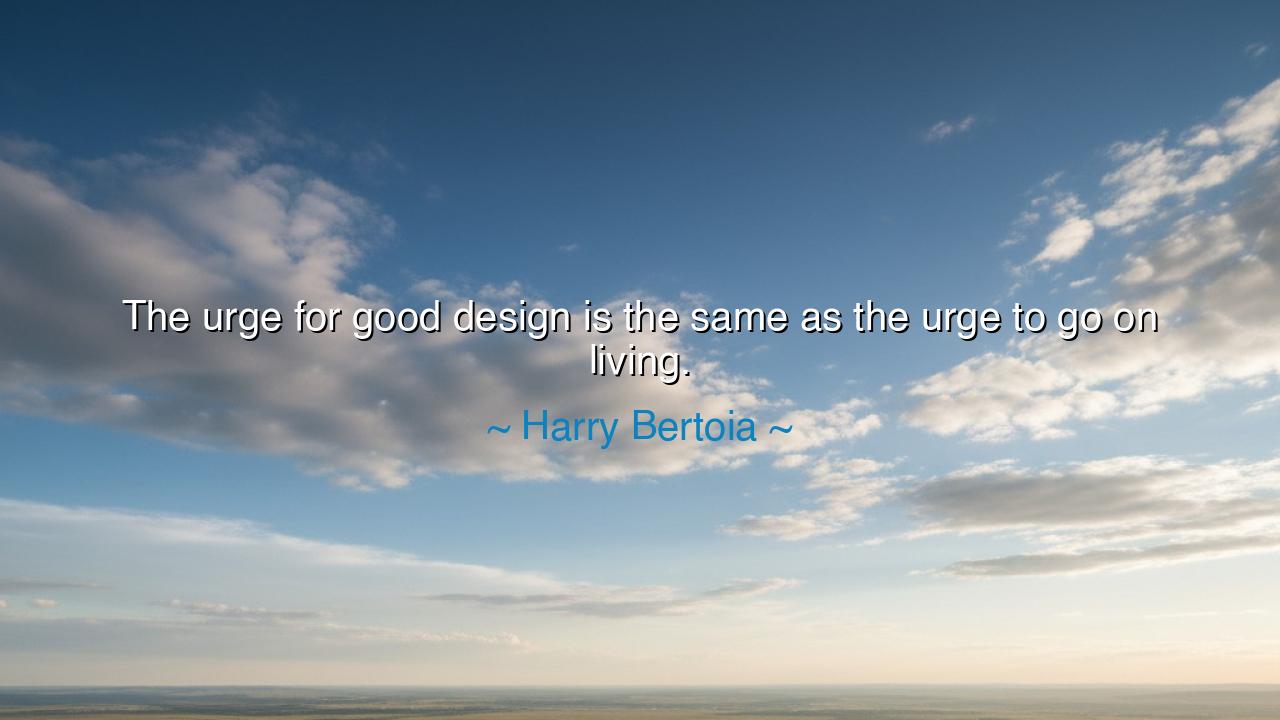
The urge for good design is the same as the urge to go on living.






The sculptor, designer, and philosopher of form Harry Bertoia once declared: “The urge for good design is the same as the urge to go on living.” These words, simple yet boundless in meaning, reveal a truth that reaches beyond art and architecture — into the very essence of human existence. For design, in Bertoia’s vision, is not a luxury nor an ornament upon life; it is life’s very expression. The same force that drives the seed to sprout, the child to grow, the artist to create — that same urge compels humankind to shape its world with intention, harmony, and beauty.
To understand this, one must look at the life of Harry Bertoia himself, a man who transformed metal into music and motion. Born in Italy and raised amid hardship, he carried within him the immigrant’s dual gift: the memory of simplicity and the dream of possibility. When he came to America, he entered a world that was rebuilding itself after war — a world hungry not just for survival, but for meaning. Through his sculptures, his furniture, and his “sound sculptures” that sang when touched by wind or hand, Bertoia gave form to the truth that to design is to affirm life, to order chaos, and to transform raw material — whether steel or spirit — into something that breathes.
When Bertoia says that the urge for good design is the same as the urge to live, he reminds us that design is not merely about appearance, but about function, connection, and flow. Just as life seeks balance — between hunger and fulfillment, motion and stillness, growth and decay — so does good design. A chair must hold the body as gently as the world holds the soul. A building must breathe as the forest breathes. A city must move with the rhythm of its people. To design well, one must understand the laws of both nature and humanity, for the two are not separate but reflections of each other. The living and the designed are bound in the same rhythm — each striving for harmony, purpose, and continuation.
Consider, for example, the story of the Bauhaus, that legendary school of design founded in Germany in the early 20th century. It was born in a time of crisis, when Europe lay in ruins after war. Yet from that devastation arose a vision of renewal — to rebuild the world with clarity, honesty, and unity. The Bauhaus masters, like Walter Gropius and Marcel Breuer, saw design as a moral act: the shaping of a better, more humane world. Their philosophy echoed Bertoia’s truth — that to design is not to decorate life, but to sustain it. Every window, every chair, every dwelling they crafted was an act of faith in the possibility of life restored, ordered, and reborn through thoughtful creation.
So too does Bertoia’s insight call to every individual. For design is not the realm of artists alone; it is the instinct that lives in all who seek to make life better — who clean their homes, plant gardens, mend garments, write music, or teach children. Every human being, in some way, is a designer of their own existence. The urge to arrange one’s surroundings with care, to bring beauty into usefulness, is nothing less than the will to keep living meaningfully. When the world descends into disorder, the soul’s response is to create order — to rebuild, to realign, to design again. Thus, creation is the antidote to despair.
And yet, Bertoia’s words also bear a challenge. For not all that is made is good, and not all that lives does so wisely. To design well — as to live well — demands awareness, humility, and respect for the whole. The designer must listen to the material; the living soul must listen to life. Both must act not in haste or vanity, but in harmony with truth. In this way, the urge for good design becomes a spiritual discipline: the pursuit of perfection not in form alone, but in purpose.
Therefore, my listener of the future, let this wisdom be your compass: design your life as if it were art, for in doing so, you join the eternal rhythm of creation. Let your choices be deliberate, your spaces harmonious, your works filled with care. Resist the careless, the chaotic, the disposable — for they diminish both design and life. Create instead with reverence, for every act of thoughtful making — whether of an object, a home, a relationship, or a legacy — affirms the will to continue, to endure, to flourish.
For in the end, Harry Bertoia’s words remind us that design and existence are twins born of the same impulse: the desire to shape chaos into order, despair into beauty, and mere survival into life worth living. To design is to declare: “I am alive, and I will make this world better than I found it.” And that, indeed, is the highest and most sacred act of creation.






AAdministratorAdministrator
Welcome, honored guests. Please leave a comment, we will respond soon